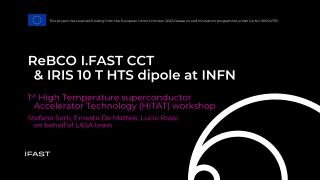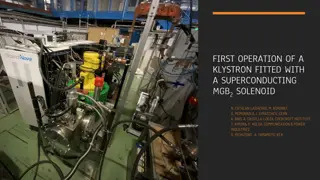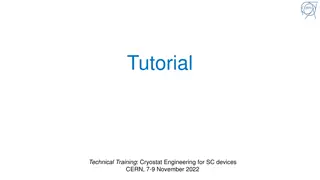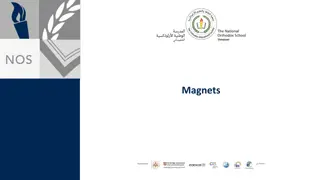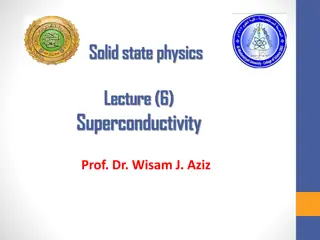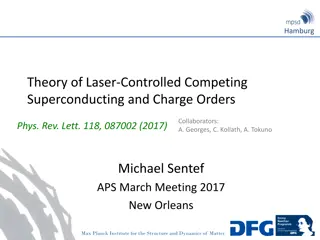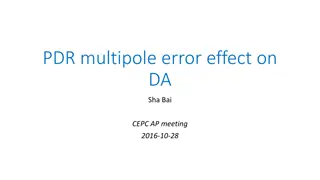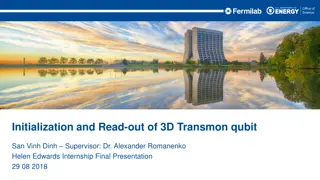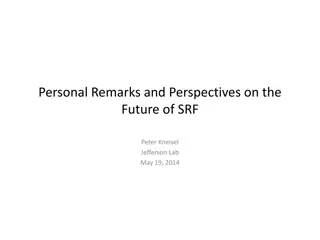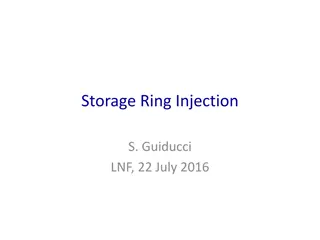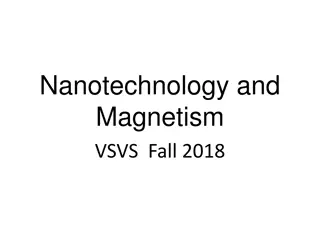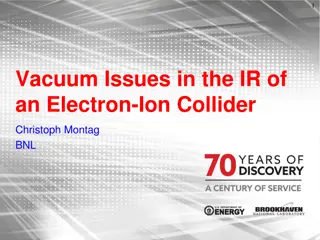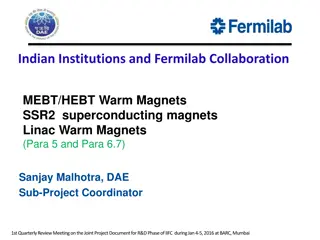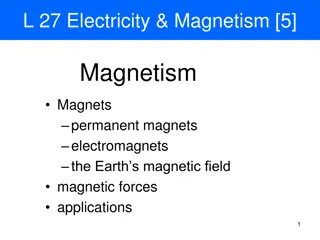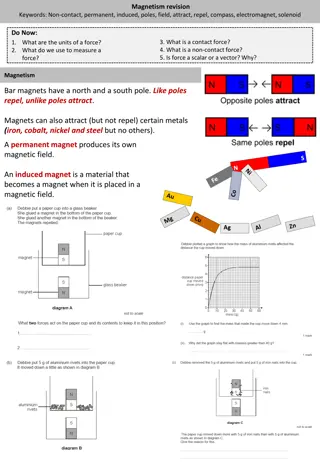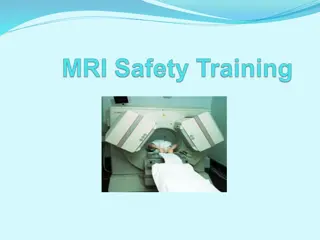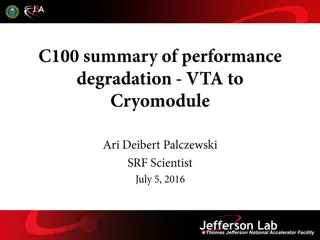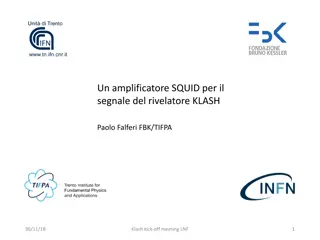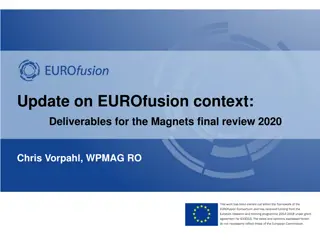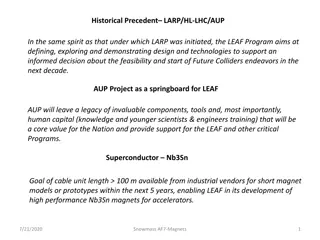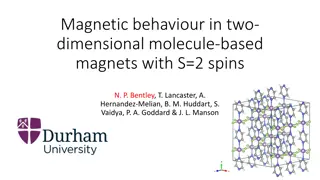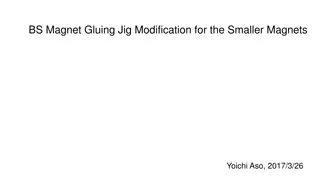Exploring Canted Cosine Theta with HTS Superconductors
This project delves into innovative superconducting magnets, particularly CCT in HTS, aiming to form strategic partnerships for HTS magnet technology in accelerators. Tasks include coordination, engineering designs, and construction of demonstrator magnets. The project also focuses on the conceptual
0 views • 16 slides
Advanced Instrumentation and Diagnostics for Superconducting Magnets at CERN
Explore the crucial needs for instrumentation and diagnostics at CERN, focusing on superconducting magnets. Topics include voltage and strain measurements, vibration analysis, temperature sensing, quench detection, and magnet form factor considerations. The importance of advanced diagnostics and com
1 views • 23 slides
Exploring Magnetism: Properties, Differences, and Similarities
Discover the properties of magnets and magnetic materials, understand the differences and similarities between permanent magnets and electromagnets. Delve into the basics of magnetism, explore magnetism stations, hypothesize about magnetic attraction, and learn interesting facts about magnets. Engag
3 views • 18 slides
Basic Principles of MRI Imaging
MRI, or Magnetic Resonance Imaging, is a high-tech diagnostic imaging tool that uses magnetic fields, specific radio frequencies, and computer systems to produce cross-sectional images of the body. The components of an MRI system include the main magnet, gradient coils, radiofrequency coils, and the
2 views • 49 slides
Advancements in Superconducting Solenoid Technology for Klystrons at CERN
Research highlights the first operation of a klystron equipped with a superconducting MgB2 solenoid, aiming to enhance efficiency and sustainability of klystron systems. The focus is on integrating novel solenoid designs, such as those proposed by A. Yamamoto, to optimize klystron performance at CER
5 views • 18 slides
Permanent Magnets Market
The global permanent magnets market size was USD 22.18 billion in 2023 and is likely to reach USD 47.5 billion by 2032, expanding at a CAGR of 8.7% during 2024\u20132032
2 views • 5 slides
Innovative Superconducting Cavities Research Project Overview
This project, funded by the European Union's Horizon 2020 program, focuses on innovative superconducting cavities coated with superconducting films. Objectives include optimizing production procedures, testing prototypes, and reducing costs. Tasks involve coordination, strategy development, and achi
2 views • 9 slides
Cryostat Engineering for SC Devices Training at CERN - November 2022
Explore the technical training on Cryostat Engineering for Superconducting devices at CERN in November 2022. Dive into the design aspects, static heat loads, and mass flows for a 400 MHz cryomodule. Tasks include conceptual design of cryostats, calculating thermal parameters, supporting systems, and
0 views • 10 slides
Understanding Magnets: Properties, Attraction, and Repulsion
Explore the fascinating world of magnets through a series of True or False questions, visual aids, and practical examples. Learn about magnetic materials, the Earth's magnetic field, and the behavior of magnets when interacting with different objects. Test your knowledge with fun activities and enha
0 views • 10 slides
Understanding Magnets and Magnetic Fields
Explore the fascinating world of magnets and magnetic materials. Discover how magnets have two poles, North and South, and how they interact with each other. Learn about magnetic materials like iron, cobalt, and nickel, and understand the concept of magnetizing and demagnetizing. Dive into the magne
0 views • 15 slides
Understanding Magnetism: Introduction to Key Concepts
Delve into the fundamentals of magnetism with a focus on magnets, magnetic fields, and induced vs. permanent magnets. Explore the concepts of attraction, repulsion, magnetic materials, and the behavior of different metals in the presence of magnets. This lesson sets the foundation for a deeper under
0 views • 19 slides
Understanding Superconductivity: A Key to Zero Resistance
Superconductivity is a fascinating phenomenon observed in certain materials where electrical resistance disappears and magnetic fields are expelled. At critical temperatures, materials become superconductors, allowing electricity to flow with zero resistance. This occurs due to electron pairs called
1 views • 28 slides
Understanding NMR Spectroscopy in Pharmaceutical Analysis
Introduction to acquiring a 1H NMR spectrum in pharmaceutical analysis, including the role of magnetic fields, use of superconducting materials, and the principles behind NMR spectrometers.
0 views • 22 slides
Understanding Energy Loss Due to Hysteresis in Magnetic Materials
In the realm of magnetism, magnetic materials exhibit unique behavior even when not magnetized. Ewing's theory sheds light on the alignment of molecular magnets in relation to an applied magnetizing field, resulting in energy consumption. This leads to hysteresis loss, where energy is dissipated as
0 views • 8 slides
Laser-Controlled Competing Superconducting and Charge Orders in Transition Metal Dichalcogenides
Hamburg Theory of laser-controlled competing superconducting and charge orders explores the use of lasers to manipulate the ordering mechanisms in transition metal dichalcogenides, leading to ultrafast switching and the induction of new states of matter. This research delves into generic mechanisms
0 views • 13 slides
Analysis of Multipole Error Effects on Beam Dynamics in CEPC Accelerator
The content discusses the impact of multipole errors on the beam dynamics at the CEPC Accelerator, focusing on sources of error, measurements, and potential effects on the beam. The analysis includes different types of multipole errors, their sources, and the resulting changes in tune and emittance
4 views • 11 slides
Exploring 3D Transmon Qubits in Quantum Computing
This document delves into the initialization, read-out, and measurement techniques of 3D transmon qubits as integral components of quantum computing. It covers the underlying principles of superconducting qubits, SRF cavity utilization, and the roadmap for improving quantum memory and coherence time
0 views • 12 slides
Neutrino Interactions with Liquid Argon at DUNE Near Detector Complex
The Deep Underground Neutrino Experiment (DUNE) aims to study neutrino oscillations using high-precision measurements with detectors like the Near Detector complex located downstream of the neutrino beam. Components such as ND-LAr and SAND play crucial roles in scanning energy spectra. SAND, a perma
0 views • 16 slides
Understanding Magnets and Electromagnets in 3rd Grade Science
Explore the unique properties of magnets and electromagnets in this 3rd Grade Science lesson. Learn about polarity, attraction, repulsion, and strength. Discover how magnets work, the importance of poles, and the behavior of like and unlike poles. Dive into the world of magnets to develop models and
0 views • 16 slides
Insights on the Future of SRF Technology by Peter Kneisel at Jefferson Lab
Peter Kneisel reflects on the past and present advancements in superconducting radiofrequency (SRF) technology, debunking the notion that Niobium has reached its limit. He discusses ongoing improvements in SRF cavities, surface treatments, and fabrication techniques, highlighting the need for cost r
1 views • 20 slides
Development of Ultra-Thin Magnets for FCC-ee Experiments
Overview of the motivation, concept, and design principles behind the development of ultra-thin magnets for FCC-ee experiments, focusing on obtaining transparent magnets, high-strength conductor development, magnet design, quench protection, and vacuum vessel transparency. The project aims to create
0 views • 9 slides
Magnetization, Decay, and Error Fields in HTS Accelerator Magnets
The research conducted at The Ohio State University focuses on understanding the magnetization, decay, and influence of error fields in high-temperature superconducting (HTS) accelerator magnets. The study explores the impact of different superconducting materials such as Nb3Sn, YBCO, and Bi:2212 on
0 views • 21 slides
Injection Process in Particle Accelerators
The injection process in particle accelerators involves transferring beams efficiently with minimal loss and emittance dilution. It includes on-axis injection onto the reference orbit using septum magnets and fast kickers to maintain beam trajectory accuracy. The design aims to achieve precise beam
0 views • 22 slides
Exploring Nanotechnology and Magnetism Applications
Discover the significance of combining nanotechnology and magnetism in various fields such as satellite movements, ophthalmology, and oil spill cleanup. Uncover the principles of magnetism through hands-on activities and discussions on permanent, temporary, and induced magnets. Engage students in pr
0 views • 11 slides
Esti-Mysteries with Magnets: Solving the Total Number Puzzle
Explore the engaging Esti-Mystery activity involving magnets to solve a puzzle and determine the total number of magnets. Follow the clues provided and use estimation to narrow down possibilities as you progress. Enhance mathematical thinking and problem-solving skills through interactive learning.
0 views • 22 slides
Challenges and Upgrades in Electron-Ion Collider Interaction Regions
The article discusses vacuum issues, design challenges, and experiences in the interaction regions of Electron-Ion Colliders. It explores the unique characteristics of the HERA collider, including beam currents, bunch spacing, and straight sections. Additionally, it covers the upgrades and improveme
0 views • 25 slides
Collaboration Between Indian Institutions and Fermilab for Magnet Production
Collaboration between Indian institutions and Fermilab for the production of various magnets for the Medium Energy Beam Transport line, including warm and superconducting magnets. Updates on the progress, deliverables, recommendations for series production, and key milestones discussed during the 1s
0 views • 12 slides
Long-term Operation of Superconducting Triplet Quadrupoles (STQ) with Cryocoolers at RIKEN
Introduction to the operational experiences, maintenance, and long-term operation of the Superconducting Triplet Quadrupoles (STQ) with cryocoolers for the BigRIPS In-flight Separator at RIKEN. Details include standard operation of SC magnets, unique features of BigRIPS and RI-beam delivery lines, S
0 views • 16 slides
Understanding Magnetism: From Permanent Magnets to Electromagnetism
Explore the fascinating world of magnetism, covering topics such as permanent magnets, electromagnets, Earth's magnetic field, and the applications of magnetic forces. Discover how magnets work, the properties of permanent magnetism, and the relationship between magnetic and gravitational fields. De
0 views • 25 slides
Exploring the World of Magnets: Designs, Properties, and Applications
Delve into the fascinating realm of magnets, learning about their composition, attraction and repulsion properties, as well as their diverse applications in various products. Discover how magnets are used in innovative designs and get inspired to create your own magnetic products.
0 views • 7 slides
Exploring Magnetism: Concepts and Applications
Understanding magnetism involves learning about magnetic fields, poles, attraction, repulsion, and electromagnetism. Explore how magnets work, magnetic fields interact, and electromagnets are created. Dive into the properties of permanent and induced magnets while uncovering the magic of compasses a
0 views • 4 slides
Understanding MRI Machine Safety and Considerations
MRI machines utilize powerful magnets and advanced technology for medical imaging. The magnets are superconducting, requiring ultra-cold temperatures for operation, and safety considerations include managing biological effects, area effects, and cryogenic gases. The magnetic fields used in MRI scans
0 views • 20 slides
Quality Control and Testing Procedures for Superconducting Radiofrequency Cavities
The presentation highlights the rigorous processes involved in qualifying superconducting radiofrequency (SRF) cavities for high-performance applications. Each cavity undergoes a detailed qualification process, including BCP treatment, electropolishing, and high-pressure rinsing, to ensure optimal p
0 views • 18 slides
Understanding the Superconducting Quantum Interference Device (SQUID)
The Superconducting Quantum Interference Device (SQUID) is a crucial component for detecting signals in devices like the KLASH detector. By combining Flux Quantization and Josephson Tunneling, the SQUID operates based on key principles such as the Josephson Equations and the Flux Quantum. Through ca
0 views • 23 slides
COVID Testing Study Magnet Reminder for At-Home Testing Cohort
A study examining COVID testing behaviors with at-home tests provided to participants through refrigerator magnets featuring survey reminder dates. The study targets vulnerable populations, including immigrant communities with diverse languages. Participants receive at-home tests for 12 months and c
0 views • 9 slides
Deliverables and Key Dates for Magnets Final Review 2020
Detailed information about the deliverables and key dates for the Magnets final review in 2020, including the creation of dossiers, IDM structure, and schedules for the DEMO gate review. The deliverables cover conceptual design, selection, validation, and technical management aspects, with a focus o
0 views • 14 slides
Long-Baseline Neutrino Facility (LBNF) Primary Beamline LCW System Overview
The Long-Baseline Neutrino Facility (LBNF) Primary Beamline Low Conductivity Water (LCW) System comprises various technical design aspects including system operational scope, major system updates, design requirements, and component summary. It involves the provision of LCW cooling for magnets and po
0 views • 14 slides
Future Colliders Program - LEAF Initiative Overview
LEAF Program aims to define, explore, and demonstrate technologies for future collider endeavors. It focuses on developing high-performance Nb3Sn and HTS magnets for accelerators, fast ramping magnets, and industrialization processes. The program seeks to build invaluable components, tools, and huma
0 views • 5 slides
Magnetic Behavior in Two-Dimensional Molecule-Based Magnets
Understanding the magnetic behavior in two-dimensional molecule-based magnets with S=2 spins, exploring MnF3(pyz) with Jahn-Teller elongated Mn(III) octahedra, and discussing the crossover between classical and quantum regimes. The research involves DFT calculations for 1D antiferromagnetic systems,
0 views • 8 slides
Magnet Gluing Jig Modification for Small Magnets
Explore Yoichi Aso's 2017 modification of a magnet gluing jig for smaller magnets, complete with detailed images showcasing the process and tools used, such as the mirror box middle plate and clearance fits. This innovative approach aims to enhance precision and efficiency in handling smaller magnet
0 views • 6 slides
